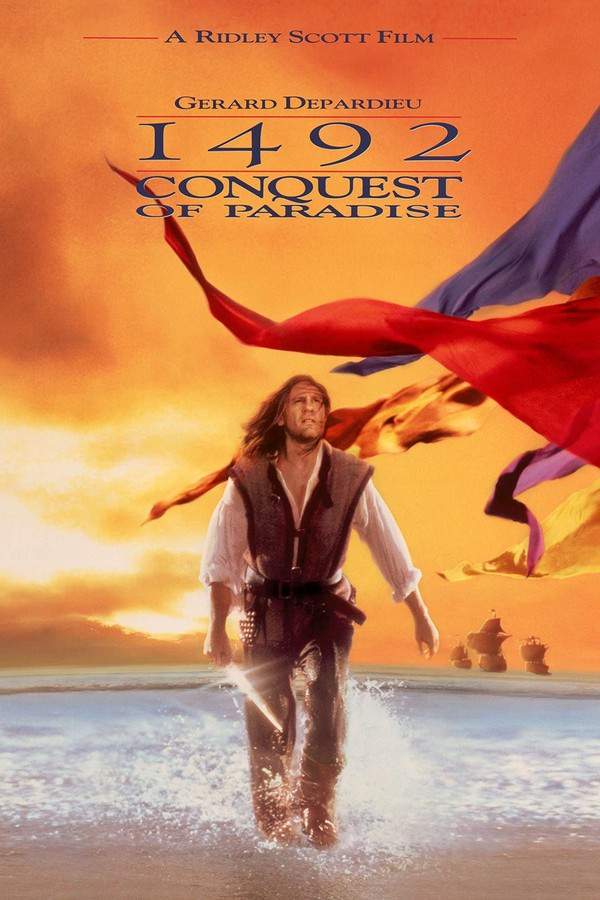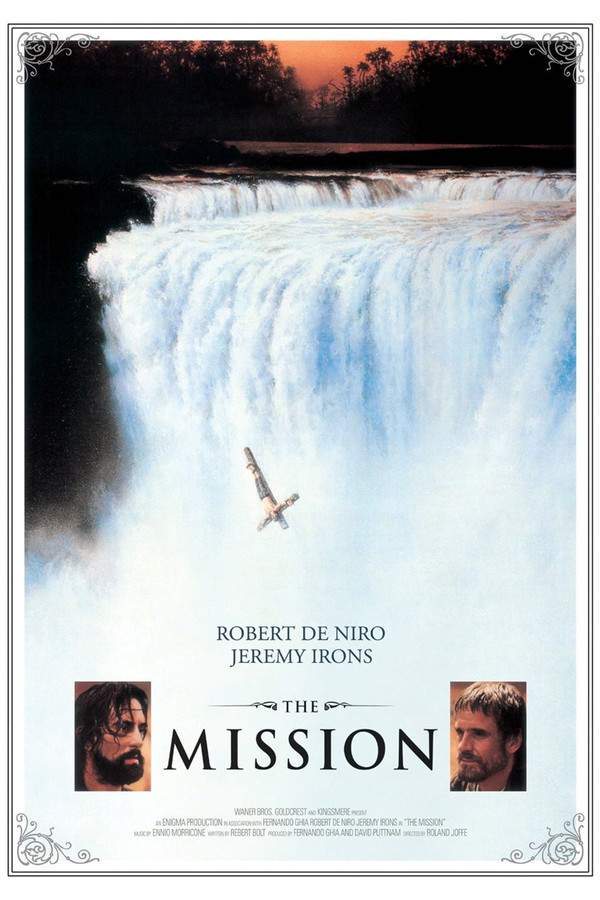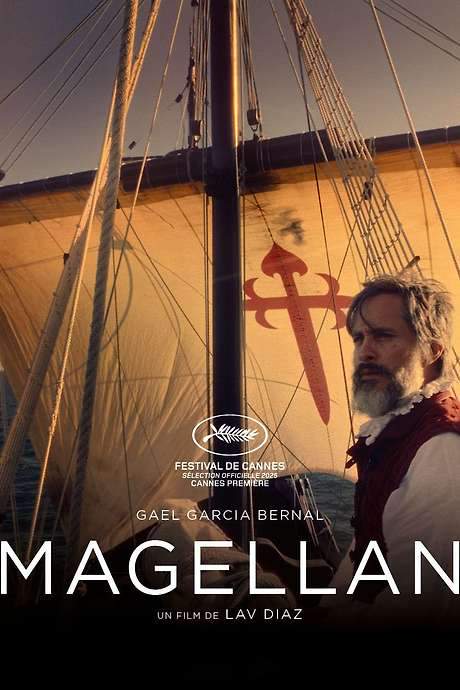
1492: Conquest of Paradise 1992
Directed by

Ridley Scott
Made by
Paramount Pictures
Test your knowledge of 1492: Conquest of Paradise with our quiz!
1492: Conquest of Paradise Plot Summary
Read the complete plot summary and ending explained for 1492: Conquest of Paradise (1992). From turning points to emotional moments, uncover what really happened and why it matters.
As Christopher Columbus embarks on his ambitious quest for a westward passage to Asia, he faces intense opposition from the skeptical Catholic theologians at the University of Salamanca, who not only doubt his plan but also dismiss the idea that the Earth is round. Undeterred, Columbus teams up with Martín Pinzón, a savvy shipowner from Palos. Together, they secure the financial backing of Santángel, a wealthy banker with a considerable debt to Queen Isabella I. After a pivotal meeting, Columbus gains her royal approval for his voyage, promising to return filled with riches of gold.
As he prepares for the voyage, Columbus finds himself in a precarious position, needing to convince his crew that the expedition will be relatively brief. He assures them of a seven-week journey while secretly bracing for an extensive and demanding adventure. Nine weeks into the trip, the crew’s morale ebbs, leading to rising tensions and threats of mutiny. In a moment of desperation, Columbus delivers an impassioned speech that is fortuitously met with a sudden gust of wind, rekindling the crew’s spirits and urging them back to their duties.
As dusk settles, Columbus’s sharp sense detects the telltale buzzing of mosquitoes on deck, signaling that land is drawing near. Soon enough, land materializes from the mist—the verdant landscapes and sandy shores of Guanahani, a pivotal point in his journey. The Europeans connect with the local natives, who proudly showcase their gold treasures. Columbus takes on the role of teacher, imparting the Spanish language to a local individual, thus bridging the communication gap. He informs the tribe of his plans to return to Spain, potentially ushering in waves of European settlers.
Upon his return to Spain, Columbus is met with a hero’s welcome, and Queen Isabella I honors him with high commendations. However, while the council expresses disappointment in the modest gold haul from his first expedition, the queen herself finds joy in his offerings. When Columbus embarks on his second expedition, he commands a fleet of 17 ships carrying over a thousand men. Tragically, upon arrival, he discovers that the settlers he left behind have met a gruesome fate at the hands of another tribe. Confronting this hostile group, Columbus learns about the unfortunate series of events inflicted upon his people. Although his commanding officer, Moxica, is skeptical, Columbus chooses to believe the survivors’ accounts and commits to constructing the city of La Isabela. He triumphantly places the town bell in its tower—a symbol of resilience and steadfast determination.
As years roll on, the native inhabitants are caught in a horrific cycle of harrowing gold mining, with failures met with brutal punishments by Moxica, who gruesomely mutilates those who do not yield results. This shocking violence sends ripples of fear throughout the region, causing many tribes to retreat deep into the forest. Backed against a wall by the growing threat of war with the numerically superior natives, Columbus finds himself in a precarious position, staring down the prospects of conflicts on multiple fronts.
Returning to Hispaniola, he is confronted with the devastation wrought by Moxica and his followers, turning his once-thriving settlement into a vision of ruin. The island stands on the edge of chaos, as tribes surge towards the Spanish settlers in anger. Stripped of his governorship, Columbus receives orders to return to Spain amidst accusations of favoritism in appointing associates to high administrative roles, which offends the noble class, including Moxica. With his power fading, he is replaced by de Bobadilla. Columbus eventually returns to Castile, only to find himself imprisoned. Fortunately, his sons intervene, securing his release, but not before he receives reluctant approval from the queen to embark on yet another voyage—this time, abandoning his brothers and vowing not to return to the New World.
In his twilight years, Columbus finds himself largely forgotten in Spain, with his discoveries overshadowed by those of Amerigo Vespucci. In this period of obscurity, his son, Ferdinand, beseeches him to recount his remarkable story, eager to document it for future generations.
1492: Conquest of Paradise Timeline
Follow the complete movie timeline of 1492: Conquest of Paradise (1992) with every major event in chronological order. Great for understanding complex plots and story progression.
Columbus's Ambitious Quest Begins
Christopher Columbus embarks on his ambitious quest for a westward passage to Asia. Despite facing intense opposition from skeptical Catholic theologians, he remains determined to prove that such a route exists.
Allies and Financial Backing
Teaming up with Martín Pinzón, a savvy shipowner from Palos, Columbus secures crucial financial support from Santángel, a wealthy banker. This backing is essential for Columbus to pursue his voyage across the uncharted oceans.
Royal Approval
After a pivotal meeting with Queen Isabella I, Columbus gains her royal approval for his journey. He promises to return filled with riches, notably gold, which further fuels his ambition and the hopes of his crew.
Anchoring Doubts Among the Crew
As Columbus prepares for the voyage, he faces skepticism from his crew regarding the length and safety of the expedition. To maintain morale, he assures them of a brief seven-week journey while preparing for the long and demanding trip ahead.
Rising Tensions at Sea
Nine weeks into the expedition, the crew's morale begins to dwindle, leading to threats of mutiny. In a moment of desperation, Columbus delivers a stirring speech, which is fortuitously reinforced by a sudden change in the wind that revives their spirits.
Discovery of Land
As night descends, Columbus detects the buzzing of mosquitoes, indicating that land is near. Soon, the crew spots the verdant landscapes and sandy shores of Guanahani, marking a significant milestone in their journey.
Interaction with Native Inhabitants
Upon landing, Columbus and his crew encounter local natives, who reveal their gold treasures. Columbus takes the role of a teacher, sharing the Spanish language with a native, fostering a connection between their two cultures.
Hero's Welcome in Spain
Columbus returns to Spain to a hero's welcome, where Queen Isabella I honors him for his discoveries. Despite some council members expressing disappointment over the modest gold haul, the queen's admiration provides Columbus with a sense of vindication.
Embarking on the Second Expedition
Inspired by his previous journey, Columbus embarks on a second expedition, commanding a massive fleet of 17 ships laden with over a thousand men. This ambitious venture reflects his unwavering determination to explore and conquer new lands.
Facing Tragedy and Hostility
Upon arrival at his previous settlement, Columbus is heartbroken to find that the settlers he left behind have met a tragic fate at the hands of hostile natives. Determined to uncover the truth, he confronts the surviving settlers to learn about the violent clashes.
Building La Isabela
Despite skepticism from his commanding officer, Columbus decides to believe the survivors' accounts of the events that transpired. He commits to establishing a new settlement, La Isabela, and symbolically places the town bell in its tower to signify resilience.
Brutality and Fear Among Natives
Years pass and the native inhabitants face horrific conditions as they are subjected to brutal methods of gold extraction. Moxica, Columbus's commanding officer, enforces violent punishments, creating fear that forces many tribes to flee into the forests.
Chaos and Loss of Power
Returning to Hispaniola, Columbus finds his settlement in ruins, ravaged by Moxica's reign of terror. Stripped of his governorship, Columbus is ordered to return to Spain amidst accusations of favoritism and corruption, marking a significant decline in his power.
Imprisonment and Release
Columbus returns to Spain to find himself imprisoned due to the fallout from the previous expedition. His sons manage to secure his release, but he faces reluctant approval from Queen Isabella for one final voyage, now with the condition of abandoning his brothers.
Twilight Years and Legacy
In his later years, Columbus feels largely forgotten in Spain as his discoveries fade into the backdrop of history, overshadowed by Amerigo Vespucci. His son, Ferdinand, implores him to recount his incredible adventures, seeking to preserve his father's legacy for future generations.
1492: Conquest of Paradise Characters
Explore all characters from 1492: Conquest of Paradise (1992). Get detailed profiles with their roles, arcs, and key relationships explained.
Christopher Columbus (Sigourney Weaver)
Columbus is portrayed as an ambitious and determined navigator, driven by his vision of discovery. He grapples with skepticism from both theologians and his crew, displaying leadership qualities as he motivates them during turbulent times. His character reflects the complexities of a man who oscillates between a visionary and a flawed leader in the face of adversity.
Moxica (Frank Langella)
Moxica serves as a fierce antagonist, embodying ruthlessness in pursuit of gold and power. His harsh leadership leads to brutal punishments for failure, instilling fear among the native populations and his fellow Spaniards. Moxica's character highlights the darker aspects of colonization and the moral decay stemming from unchecked ambition.
Martín Pinzón (Gérard Depardieu)
Pinzón is a savvy shipowner who plays a crucial role in Columbus's expedition. His character balances pragmatism with loyalty, providing essential support during the voyage. Pinzón embodies the spirit of collaboration, showcasing the importance of partnerships in exploration.
Queen Isabella I (Ángela Molina)
Isabella I is portrayed as a benevolent yet pragmatic ruler, weighing the risks and rewards of Columbus's voyages. Her approval of the expedition highlights her belief in the potential of new trade routes, but her reaction to the modest returns speaks to the challenges of leadership. Isabella's character illustrates the complexity of power in the context of exploration.
1492: Conquest of Paradise Settings
Learn where and when 1492: Conquest of Paradise (1992) takes place. Explore the film’s settings, era, and how they shape the narrative.
Time period
15th Century
The late 15th century was marked by exploration and expansion as European powers sought new trade routes and territories. This era saw a significant cultural and economic shift due to the encounters between European explorers and the indigenous populations of the Americas. The conflict between ambition, discovery, and the ensuing consequences of colonialism also unfolded during this tumultuous period.
Location
Guanahani, Hispaniola, Castile
Guanahani, known today as San Salvador Island, is where Columbus first made landfall in the Americas, characterized by its verdant landscapes and sandy shores. It represents a pivotal moment in the Age of Discovery, highlighting the initial encounters between Europeans and the Indigenous populations. Hispaniola, the larger island that includes modern-day Haiti and the Dominican Republic, became a significant site for Columbus's settlements and interactions with native tribes.
1492: Conquest of Paradise Themes
Discover the main themes in 1492: Conquest of Paradise (1992). Analyze the deeper meanings, emotional layers, and social commentary behind the film.
🏴☠️
Colonization
The theme of colonization permeates the narrative as Columbus's voyages lead to the encounter with native tribes and the subsequent exploitation of their resources. The film explores the consequences of ambition, showcasing both the allure of discovery and the dark realities that accompany colonization. Ultimately, it raises questions about power dynamics and the impact on indigenous cultures.
⛵
Adventure
Adventure is central to Columbus's quest, driven by his desire to discover new lands and riches. The perilous journey across uncharted waters and the challenges faced by Columbus and his crew underline the spirit of exploration. This theme evokes a sense of courage amid uncertainty, as characters navigate both external and internal conflicts.
⚖️
Justice
Justice emerges as a theme through the conflict with Moxica and the struggles faced by the native inhabitants. The harsh treatment of natives in the name of gold mining leads to moral dilemmas and questions about fairness in leadership. The film examines how the desire for wealth can lead to injustice and suffering.

Coming soon on iOS and Android
The Plot Explained Mobile App
From blockbusters to hidden gems — dive into movie stories anytime, anywhere. Save your favorites, discover plots faster, and never miss a twist again.
Sign up to be the first to know when we launch. Your email stays private — always.
1492: Conquest of Paradise Spoiler-Free Summary
Discover the spoiler-free summary of 1492: Conquest of Paradise (1992). Get a concise overview without any spoilers.
In the waning days of the fifteenth century, a restless Europe looks westward with both hope and doubt. Against a backdrop of scholarly skepticism and royal ambition, the film paints a sweeping canvas of oceans, uncharted islands, and the shimmering promise of a new horizon. The tone balances the awe of discovery with a brooding undercurrent of political intrigue, inviting viewers to feel the weight of history while lingering on the untamed beauty of an untouched world.
Christopher Columbus emerges as a visionary driven by a mixture of faith, curiosity, and personal conviction. He convinces a wary crew that the journey will be brief, yet the vastness of the sea and the unknown shore test his resolve at every turn. His determination is matched by a deep‑seated desire to find a peaceful paradise, a motif that colors his interactions with both his sailors and the native peoples he encounters. The film lingers on his charismatic leadership, his moments of doubt, and the quiet moments when he pauses to absorb the alien landscape.
Opposite him stands Don Adrian de Moxica, a nobleman whose ambitions are shaped by conquest and the lust for wealth. While sharing the same goal of reaching the New World, his vision veers toward domination, setting up a subtle yet potent ideological clash. The tension between Columbus’s idealistic yearning and Moxica’s relentless drive creates a charged atmosphere that fuels the narrative, hinting at the larger conflicts that will soon unfold without revealing them outright.
Together, these figures navigate a world where the seas are both a barrier and a bridge, where the promise of a new realm is tinged with the uncertainty of human desire. The film’s rich visual palette, measured pacing, and evocative score combine to plunge the audience into an age of bold exploration, leaving the exact outcome of their intersecting paths tantalizingly open.
Can’t find your movie? Request a summary here.
Movies with Similar Twists and Themes
Uncover films that echo the narrative beats, emotional arcs, or dramatic twists of the one you're exploring. These recommendations are handpicked based on story depth, thematic resonance, and spoiler-worthy moments — perfect for fans who crave more of the same intrigue.
Featured on this page

What's After the Movie?
Not sure whether to stay after the credits? Find out!
Explore Our Movie Platform
New Movie Releases (2025)
Famous Movie Actors
Top Film Production Studios
Movie Plot Summaries & Endings
Major Movie Awards & Winners
Best Concert Films & Music Documentaries
Movie Collections and Curated Lists
© 2025 What's After the Movie. All rights reserved.








